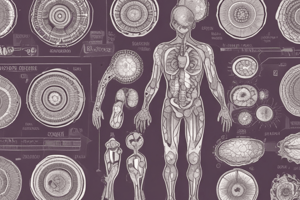Podcast
Questions and Answers
What is the main function of muscle tissue?
What is the main function of muscle tissue?
- Covering external surfaces and lining internal ones
- Generating force to move bones (correct)
- Transmitting information throughout the body
- Providing support for the body's structure
Which type of tissue allows for the coordination of various functions in the body?
Which type of tissue allows for the coordination of various functions in the body?
- Muscle tissue
- Connective tissue
- Epithelial tissue
- Nervous tissue (correct)
What is the function of connective tissues in the body?
What is the function of connective tissues in the body?
- Transmitting information throughout the body
- Providing support for the body's structure (correct)
- Generating force to move bones
- Covering external surfaces and lining internal ones
Which component of the cell contains proteins, lipids, carbohydrates, and other molecules?
Which component of the cell contains proteins, lipids, carbohydrates, and other molecules?
What is the primary function of epithelial tissue?
What is the primary function of epithelial tissue?
In a cell, where does the DNA reside?
In a cell, where does the DNA reside?
Which system is responsible for removing waste products and maintaining fluid balance in the body?
Which system is responsible for removing waste products and maintaining fluid balance in the body?
What is the main function of the cardiovascular system?
What is the main function of the cardiovascular system?
Which system plays a crucial role in immune function?
Which system plays a crucial role in immune function?
What is the purpose of electrolytes like sodium and potassium in the body?
What is the purpose of electrolytes like sodium and potassium in the body?
In the respiratory system, what structures allow for gas exchange between the air we breathe and our bloodstream?
In the respiratory system, what structures allow for gas exchange between the air we breathe and our bloodstream?
Approximately what percentage of an adult's body weight comes from water?
Approximately what percentage of an adult's body weight comes from water?
Study Notes
Anatomy and Physiology 2: Understanding the Cell, Tissues, and Systems
In the world of human biology, Anatomy and Physiology (A&P) is a critical field that encompasses both the structure and function of the body's systems. After completing the introductory A&P course, learners typically progress to the intermediate level, which delves deeper into various organ systems and their components. Here, we explore the second part of A&P, focusing on the cellular level, tissues, and several major systems.
Cell and Tissues
At the core of life lies the cell, the basic unit of all living organisms. Cells consist of cytoplasm—a gel-like substance that contains proteins, lipids, carbohydrates, and other molecules within its membrane—and a nucleus where DNA resides. Functions of cells vary based on their location in the body; however, they perform three main tasks: growth, secretion, and movement.
Tissues are groups of similar cells organized together to carry out specific functions. Four primary types of tissues exist: epithelial, connective, muscle, and nervous. Epithelial tissue covers external surfaces while lining internal ones and protects organs. Connective tissues provide support for the body's structure and allow for movement. Muscle tissue generates force to move bones by contracting or relaxing fibers within it. Finally, nervous tissue transmits information throughout the body, allowing for coordination of various functions.
Systems Overview
The human body is organized into several major systems that work together to maintain life:
- Cardiovascular System: This system delivers oxygenated blood and nutrients from the heart to cells throughout the body. It includes the heart, lungs, arteries, veins, capillaries, and blood components like red and white blood cells.
- Lymphatic System: A network of vessels and nodes responsible for removing waste products and maintaining fluid balance in the body. It plays a crucial role in immune function as part of the immune system.
- Immune System: Comprising organs such as the spleen and lymph nodes, along with specialized cells called leukocytes, this system identifies and defends against foreign substances and pathogens.
- Respiratory System: Consisting mainly of the nose, trachea, bronchioles, and lungs, this system allows for gas exchange between the air we breathe and our bloodstream.
- Fluids & Electrolytes: Approximately 60% of an adult's body weight comes from water, which helps regulate temperature, dissolve nutrients, and facilitate chemical reactions. Electrolytes, such as sodium and potassium, are vital for proper cellular function and communication.
Understanding these topics in detail requires extensive study, including memorization of key terms and concepts, mastery of diagrams illustrating structures, and understanding of the relationships among various organ systems. As always, hands-on experience through lab work can help solidify knowledge and provide practical context.
Studying That Suits You
Use AI to generate personalized quizzes and flashcards to suit your learning preferences.
Description
Test your knowledge on cell structure, tissue types, and major body systems in this intermediate Anatomy and Physiology quiz. Explore the fundamentals of cells, tissues, the cardiovascular system, lymphatic system, immune system, respiratory system, and fluids & electrolytes.





